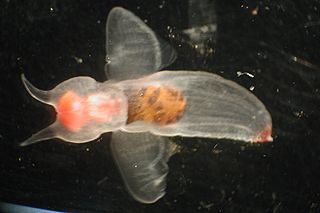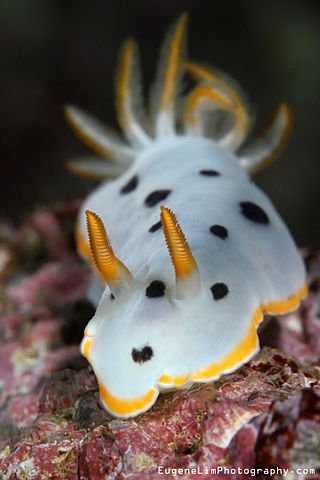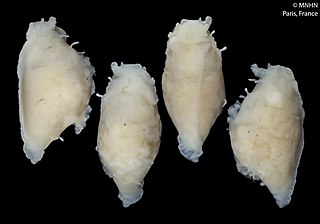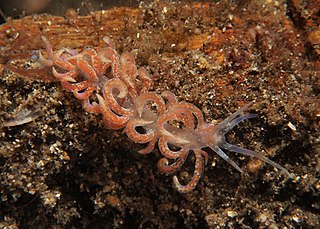
Nudibranchs are a group of soft-bodied marine gastropod molluscs that shed their shells after their larval stage. They are noted for their often extraordinary colours and striking forms, and they have been given colourful nicknames to match, such as "clown", "marigold", "splendid", "dancer", "dragon", and "sea rabbit". Currently, about 3,000 valid species of nudibranchs are known.

Sea angels are a large group of small free-swimming sea slugs, not to be confused with Cnidarians, classified into six different families. They are pelagic opisthobranchs in the clade Gymnosomata within the larger mollusc clade Heterobranchia. Sea angels were previously referred to as a type of pteropod.

Sea slug is a common name for some marine invertebrates with varying levels of resemblance to terrestrial slugs. Most creatures known as sea slugs are gastropods, i.e. they are sea snails that over evolutionary time have either completely lost their shells, or have seemingly lost their shells due to having a greatly reduced or internal shell. The name "sea slug" is most often applied to nudibranchs, as well as to a paraphyletic set of other marine gastropods without obvious shells.Cucumber

Ocythoe tuberculata, also known as the tuberculate pelagic octopus or football octopus, is a pelagic octopus. It is the only known species in the family Ocythoidae.
The Notobranchaeidae, or "naked sea butterflies", are a taxonomic family of floating sea slugs, specifically under the subclass Opistobranchia, also called "sea angels".

Aequorea victoria, also sometimes called the crystal jelly, is a bioluminescent hydrozoan jellyfish, or hydromedusa, that is found off the west coast of North America.

Velella is a monospecific genus of hydrozoa in the Porpitidae family. Its only known species is Velella velella, a cosmopolitan free-floating hydrozoan that lives on the surface of the open ocean. It is commonly known by the names sea raft, by-the-wind sailor, purple sail, little sail, or simply Velella.

Glaucus atlanticus is a species of small, blue sea slug, a pelagic (open-ocean) aeolid nudibranch, a shell-less gastropod mollusk in the family Glaucidae.

The pelagic thresher is a species of thresher shark, family Alopiidae; this group of sharks is characterized by the greatly elongated upper lobes of their caudal fins. The pelagic thresher occurs in the tropical and subtropical waters of the Indian and Pacific Oceans, usually far from shore, but occasionally entering coastal habitats. It is often confused with the common thresher, even in professional publications, but can be distinguished by the dark, rather than white, color over the bases of its pectoral fins. The smallest of the three thresher species, the pelagic thresher typically measures 3 m (10 ft) long.

The Phylliroidae are a family of nudibranch sea snails, highly adapted to a pelagic lifestyle and occurring in tropical surface waters around the globe. The two species of the genus Phylliroe and Cephalopyge trematoides that have been assigned to this family are small to average in size, slender and highly transparent. They swim by undulating their whole body. Their foot is very small, which helps to reduce drag. They are carnivores that prey on planktonic jelly fish.

Phylliroe bucephala is a parasitic species of pelagic nudibranch, a marine gastropod mollusc in the family Phylliroidae.

Chromodoris magnifica is a sea slug, a species of nudibranch, a shell-less marine gastropod mollusc in the family Chromodorididae. It is the type species of the genus Chromodoris.

Hypselodoris tryoni is a species of sea slug, a druid nudibranch, a marine gastropod mollusk in the genus Chromodorididae.

Ceratosoma amoenum, or the clown nudibranch, is a species of colorful dorid nudibranch, a sea slug, a shell-less marine gastropod mollusk in the family Chromodorididae.

Pteraeolidia ianthina is a sea slug, an aeolid nudibranch in the family Facelinidae. It is known as a blue dragon, a name it shares with Glaucus atlanticus and Glaucus marginatus.

Chromodoris orientalis is a species of colourful sea slug, a dorid nudibranch, a marine gastropod mollusc in the family Chromodorididae. Sea slugs are generally very beautifully colored organisms with intense patterns and ranging in sizes. The Chromodoris orientalis specifically is a white sea slug with black spots in no particular pattern with a yellow, orange, or brown in color ring around its whole body and on its gills. There is much discussion on where it is found, what it eats, how it defends itself without a shell, and its reproduction methods. This is all sought after information because there is not much known about these animals.

Scyllaea pelagica, common name the sargassum nudibranch, is a species of nudibranch, a marine gastropod mollusc in the family Scyllaeidae. This species lives among floating seaweed in the world's oceans, feeding on hydroids.
Cephalopyge trematoides is a pelagic species of nudibranch. A free-swimming marine gastropod in the family Phylliroidae. Cephalopyge trematoides is the only known species in its genus.

Okenia zoobotryon is a species of sea slug, a dorid nudibranch, a marine gastropod mollusc in the family Goniodorididae. It is normally found on the colonial bryozoan Amathia verticillata on which it lives and feeds.

Phyllodesmium poindimiei is an Alcyonacea feeding, aeolid nudibranch Gastropod belonging to the family Facelinidae. Cerata are important in this clade in terms of their physical defense and efficient metabolic processes. This species is spread sporadically along tropical coastal regions such as Australia, Hawaii, and the Indo-Pacific living in diverse marine habitats such as coral reefs. Unlike other species in the Opisthobranch Mollusca clade, P. poindimiei’s lush pink cerata are used for defensive purposes other than Nematocyst (dinoflagellate) capture and toxin release. Organismal ties within these thriving, tropical ecosystems can be determinants of environment change, which affects massive coral ecosystems. Continuously changing marine ecosystems, such as coral reefs, are directly linked to the evolution of organisms that live and thrive in the tropics such as the soft nudibrach P. poindimiei.
















